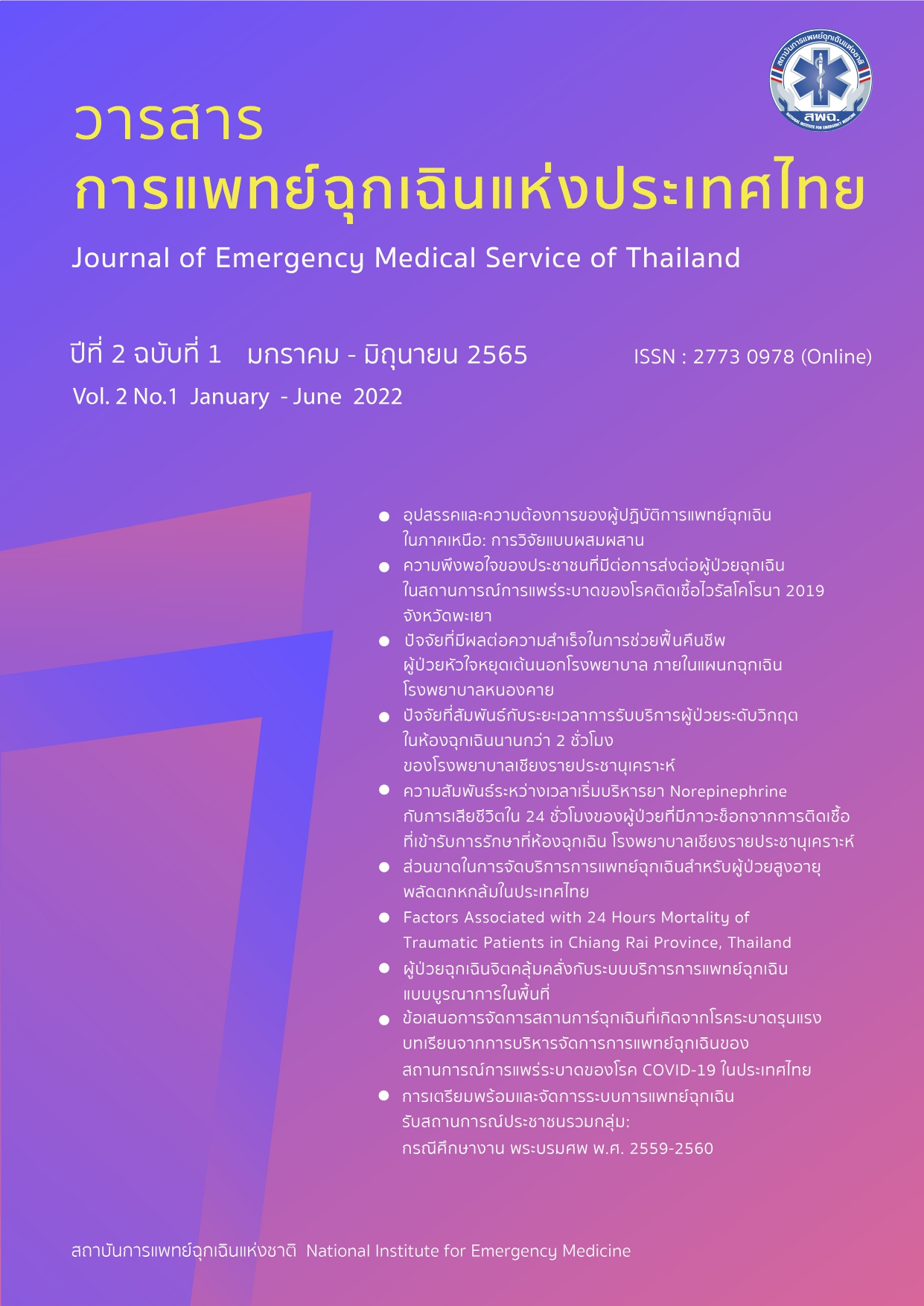Factors Associated with 24 Hours Mortality of Traumatic Patients in Chiang Rai Province, Thailand
DOI:
https://doi.org/10.14456/jemst.2022.7Keywords:
trauma dead, injury severity score (ISS), revised trauma score (RTS), Glasgow coma scale (GCS))Abstract
Trauma is a major health problem throughout the world, leading to death and disability. Many resources are being used to treat traumatic patients. If correctable factors can be identified, the mortality could be reduced significantly. This study aimed to analyze the factors association with mortality in traumatic patients. A retrospective cohort study was conducted in adults ≥18 years old who visited the emergency department with trauma and were triaged to ESI level 1. The samples were divided into 2 groups: a 24-hour survival group and a 24-hour no survival group, which were compared by age, sex, underlying diseases, etiology of trauma, organ of injury, patient transfer method, mechanism of injury, late admission from the onset, and traumatic scores (including GCS, RTS and ISS). Laboratory studies include hematocrit level, platelet level, and INR level. The significant factors were analyzed by using univariable and multivariable analysis in a logistic regression. As for the results, the patients in each group were: the survival group (N=317, 79.25%) and the 24- hour non survival group (N = 83, 20.75%). After adjusting for factors significantly related to the outcome, it was found that death cases due to trauma were more likely associated with diabetes mellitus, head injury, GCS≤8, RTS 15, patient transfer time ≥240 min, hematocrit 15 and INR ≥1.5 as possible risk factors associated with traumatic patient mortality.
References
Heydari-Khayat N, Sharifipoor H, Rezaei MA, Mohammadinia N, Darban F. Correlation of revised trauma score with mortality rate of traumatic patients within the first 24 hours of hospitalization. Zahedan J Res Med Sci 2014;16(11):33-6.
Brown TR. Pre-hospital care of road traffic injuries in Chiang Mai [Internet]. [cited 2020 Oct 10]. Available from: http://who.int/world-health-day/previous/2004/en/traffic_facts_en.pdf
Reinhard E. Traffic facts [Internet]. 2014 [cited 2020 Oct 10]. Available from: https://www.who.int/worldhealth-day/previous/2004/en/traffic_facts_en.pdf
World Health Organization. Review of Thailand’s status against voluntary global targets for road safety risk factors and service delivery mechanism. Geneva: World Health Organization; 2020.
Li H, Shen WF, He XJ, Wu JS, Yi JH, Ma YF. Evaluation of the revised trauma score in predicting outcomes of trauma patients. Hong Kong J Emerg Med 2013; 20(4):234–9.
Alvarez BA, Razente DM, Lacerda DA, Lother NV, Von-Bahten LC, Stahlschmidt CM. Analysis of the revised trauma score (RTS) in 200 victims of different trauma mechanisms. Revista do Colégio Brasileiro de Cirurgiões 2016;43(5):334–40.
Javali R, Krishnamoorthy, Patil A. Comparison of injury severity score, new injury severity score, revised trauma score and trauma and injury severity score for mortality prediction in elderly trauma patients. Indian J crit Care Med 2019;23:73-7.
Bolorunduro OB, Villegas C, Oyetunji TA, Haut ER, Stevens KA, Chang DC, et al. Validating the injury severity score (ISS) in different populations: ISS predicts mortality better among Hispanics and females. J Surg Research 2011;166(1):40–4.
Brohi K, Cohen M, Ganter M, Schultz M, Levi M, Mackersie R, et al. Acute coagulopathy of trauma: hypoperfusion induces systemic anticoagulation and hyperfibrinolysis. J Trauma Acute Care 2008;64(5):1211-7.
Fawzy A, Lolah M, Ibrahim S, Hassan A. Coagulation profile tests as a predictor for adult trauma patients’ mortality. Int Surg J 2020;7(1):1-9.
Wongvatanakij P, Tadadej C, Meyai A, Suriyawongpaisal P. Relation of factor on survival outcomes among traumatic patients at the tertiary care hospital admitted for traffic accidents in Phuket Province. Srinagarind Medical Journal 34(1):52-9.
Yumoto T, Naito H, Ihoriya H, Yorifuji T, Nakao A. mortality in trauma patients admitted during, before, and after national academic emergency medicine and trauma surgery meeting dates in Japan. PLoS One 2019;14(1):1– 11.
Ustundag M, Aldemir M, Orak M, Guloglu C. Predictors of mortality in blunt multi-trauma patients: a retrospective review. Hong Kong J Emer Med 2010;17(5): 471–6.
Suriyawongpaisal P, editor. Key facts on road safety situations in Thailand. 1st edition. Bangkok: Roads Safety Fund, Department of Land Transport; 2015.
He K, Hemmila MR, Cain-Nielsen AH, MachadoAranda DA, Frydrych LM, Delano MJ. Complications and resource utilization in trauma patients with diabetes. PLOS ONE 2019;14(8):1-13.
Guzman-Martinez AM, Garcia-Rodriguez O, Ramos-Melendez EO, Guerrios-Rivera L, Rodriguez-Ortiz P. Morbidity and mortality of Hispanic trauma patients with diabetes mellitus. Euro J Trauma & Emerg Surg 2018;46(4):887–93.
Khan A, Zafar H, Naeem SN, Raza SA. Transfer delay and in-hospital mortality of trauma patients in Pakistan. Int J Surg 2010;8(2):155–8.
Yattoo GH, Tabish A. The profile of head injuries and traumatic brain injury deaths in Kashmir. J trauma Management & Outcomes 2008;2:5-9.
Ahmad R, Cherry RA, Lendel I, Mauger DT, Service SL, Texter LJ, et al. Increased hospital morbidity among trauma patients with diabetes mellitus compared with age- and injury severity score-matched control subjects. Arch Surg 2007;142(7):613–8.
Schwartz GR, Schwartz GR, Mayer TA, Goldman HW. 18–2 Head Injuries: Specific Emergency Department Management Issues. In: Roth PB, Cohen JS, editors. Principle and practice of emergency medicine. 4th edition. Philadelphia: Lippincott, Williams & Wilkins; 1998. p. 232–4.
Yadollahi M. A study of mortality risk factors among trauma referrals to trauma center, Shiraz, Iran, 2017. Chin J Traumatol 2019;22(4):212–8.
Türker FS. Hemorrhagic shock. Clinical Management of shock - the science and art of physiological restoration [Internet]. [cited 2020 Oct 10]. Available from: https:// doi.org/10.5772/intechopen.82358
Yuan F, Ding J, Chen H. Predicting outcomes after traumatic brain injury; the development and validation of prognostic models base on admission characteristic, The J Trauma Acute Care Surg 2012;73:137-45.
Downloads
Published
How to Cite
Issue
Section
License
Copyright (c) 2022 Journal of Emergency Medical Services of Thailand

This work is licensed under a Creative Commons Attribution-NonCommercial-NoDerivatives 4.0 International License.






